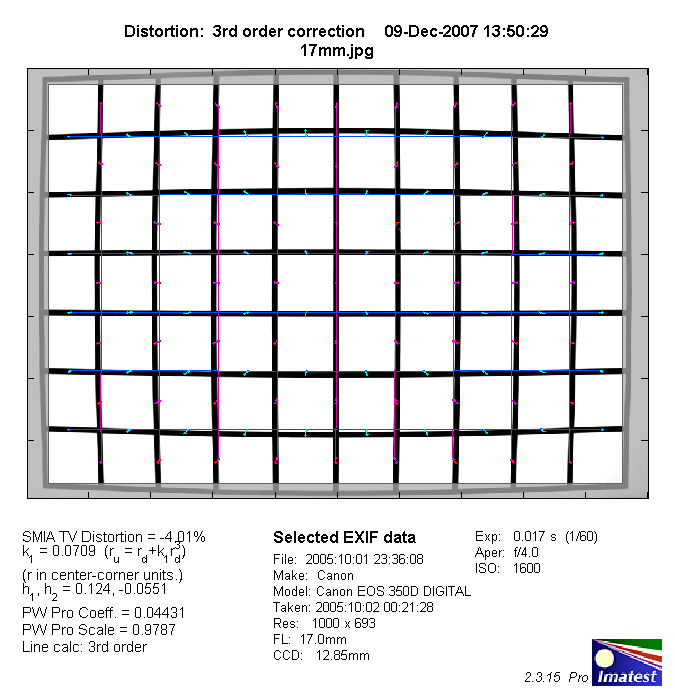|
Canon EF-S 17-85mm f/4-5.6 USM IS - Retest @ 15MP / Review - Analysis |
|
Lens Reviews -
Canon EOS (APS-C)
|
|
Page 2 of 2

Distortion
The data has been taken from the old review because this characteristic cannot change when moving to a different sensor with the same physical size.
The lens broke a new record here - at 17mm it shows the most pronounced barrel distortion of all (supposedly) corrected lenses tested to date. Typical for all standard zoom lenses the barrel distortion change to pincushion distortion when zooming towards the long end of the zoom range. At about 24mm both forces even out technically though there're still some wavy-like distortions left here. At 50mm and 85mm the level of pincushion distortion remain relatively slight so for most of the zoom range the performance is actually pretty decent.
|
Move the mouse cursor over the focal length text marks below to observe the respective distortion
|
| 17mm |
24mm |
50mm |
85mm |
|

|
The chart above has a real-world size of about 120x80cm or 60x the focal length.
Expect higher distortion levels towards closer focus distances.
Vignetting
APS-C DSLRs can take advantage of the sweet spot of the lens here usually resulting in pretty decent vignetting figures. However, the EF-S 17-85mm is a native APS-C lens with a reduced image circle so it is not surprising that vignetting is far more pronounced exceeding 1.4EV at 17mm @ f/4 and 0.7EV at 85mm @ f/5.6. As usual stopping down a little helps to reduce the problem significantly.
It is interesting to note that the new sensor design (supposedly optimized photo-diodes) of the EOS 50D have no significant impact on the vignetting figures compared to the old EOS 350D.

MTF (resolution)
The lens produced a decent performance in the lab but not without flaws. The center performance is generally great throughout the whole zoom range. Unsurprisingly the weak spot is a the wide end with a pretty good border performance but slightly softer outer corners. The situation improves a bit 24mm with a generally good to very good border quality. There's nothing to complain about at 50mm and 85mm with a very good performance across the frame.
It is pretty surprising that the performance charts look very similar compared to the old 8mp test but boosted to a higher level on the scale. The different RAW converter has certainly an impact here (the old tests were performed using ACR 3.2 which produces comparatively softer results) and the new sensor (AA-filter etc. pp) may have some stakes in here.
Please note that the MTF results are not directly comparable across the different systems!
Below is a simplified summary of the formal findings. The chart shows line widths per picture height (LW/PH) which can be taken as a measure for sharpness.
If you want to know more about the MTF50 figures you may check out the corresponding Imatest Explanations
Chromatic Aberrations (CAs)
Chromatic aberrations (color shadows at harsh contrast transitions) can be a significant problem from 17mm to 24mm where the average CA pixel width at the image corners can exceed 2 pixels. The problem decreases a little at 50mm and the problem isn't overly significant anymore at 85mm.
Compared to the old EOS 350D tests it is pretty obvious that the CA figures scale relative to the higher resolution of the EOS 50D.

Verdict
The Canon EF-S 17-85mm f/4-5.6 USM IS is a lens that promises many things. It is certainly a very versatile standard zoom with a long zoom range and an image stabilizer that can save the day in many situations. However, the build quality is somewhat disappointing and optically it is also something of a mixed bag. The lens is very sharp in the image center throughout the range but at the wide-end the corners are generally somewhat softer (but still acceptable). The 17mm setting also suffers from rather extreme distortions and rather hefty vignetting @ f/4. Finally chromatic aberrations aren't really something to rave about either.
So at the end of the day it remains a lens with a couple of compromises in terms of quality. It is more versatile in terms of range than the EF-S 17-55mm IS and EF-S 18-55mm IS and a bit better compared to the new EF-S 18-200mm IS.
| Optical Quality: |  |
| Mechanical Quality: |  |
| Price/Performance: |  |
|